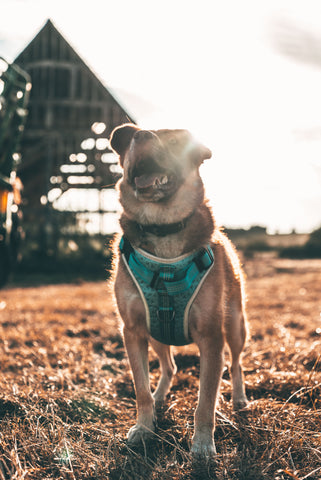How to Stop Your Dog From Lunging at Other Dogs

What makes a dog lunge when they're on a leash? Let's think about your dog's body language for a minute here. What does your dog look like when she's having fun?
Her face muscles are soft and her mouth is probably slightly open. Her ears might be up or back. Her tail is sweeping softly back and forth or if she’s excited she may be doing a full butt wiggle along with circle wags. But what does she look like when she's barking at another dog? Her lips curl in a snarl. She barks deep and loud. She flings herself forward, muscles tight, and her tail may be tensed over her back or tucked between her legs. This is referred to as 'Barrier Frustration'. This can mean barking, lunging and other behaviors like climbing or jumping. Dogs who are frustrated in this way need to be given an outlet for their stress and an appropriate way to redirect their excess energy. Leaving them to their own devices won't help. Your dog is not likely to settle down until the dog she's barking at is far enough away. So what are some tools and tips to stop your dog from lunging?

Teach and Reward Attentiveness
If your dog is bouncy by nature, it will be hard for her to pay attention. Teach her to look at you when you call her name. She can also be taught to check in with your spontaneously and often. The more your dog's attention is focused on you, the less she has for other dogs. It is important to practice this without other dogs around. Use her favorite treats, so that looking at you is the most rewarding thing she can find to do. Making focus fun is part of the training, like tossing treats on the ground for her to find.
Keep the Distance
You've taken your dog on enough walks to know how close she can get to another dog without getting freaked out. When you're training her, work with that distance as much as possible. It's important that you use a fixed length leash, instead of one that extends. With time, your dog will get better and better at paying attention to you, and keeping calm when other dogs are around. If all goes well, you can gradually decrease the distance.
Practice with a Doggie Friend
Dog parents have friends who are also dog parents. One of your friends must have a dog that is more laid back than yours. Ask your friend and their dog for help with training. Your friend stands with their dog at a distance where your dog stays calm. Then you and your dog approach slowly, and keep rewarding her for focusing on you and walking calmly. If she starts getting hyper and over excited, lead her away and practice at a distance some more. You can also practice this with the other dog approaching. This will give your dog to practice and hone her 'stay' and 'sit' skills.
You'll see that your dog will get the hang of it soon enough. The sessions might have to be short at first, but practicing is key. If you don't train her well, she won't learn.

Use the Right Tools
If your dog has a tendency to lunge and you are using a collar, this can put a lot of pressure on your dog’s trachea and respiratory system. A harness will be a much better alternative at least until you’ve trained your dog to not lunge or get so excited. Instead, use a dog harness or a head halter for optimal control. This will prevent your dog from hurting himself. Finding the right dog harness is important. Check out our harnesses, which come in fun colors!
Be ready for setbacks when you're training your dog. Every dog learns at their own pace. Don't use any form of punishment. Scolding her for reacting to other dogs will only cement the negative association she has with seeing different dogs and bad things happening. Just remember, if your dog starts reacting, move farther away and try again. Keep the practice sessions fun and positive.




Leave a comment